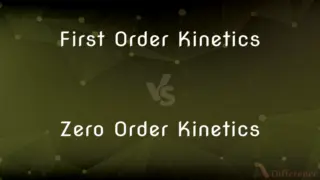Grana vs. Thylakoid — What's the Difference?
By Tayyaba Rehman — Published on December 9, 2023
Grana are stacks of thylakoids in chloroplasts, while thylakoids are flattened sacs inside chloroplasts where photosynthesis occurs.

Difference Between Grana and Thylakoid
Table of Contents
ADVERTISEMENT
Key Differences
Grana and thylakoids are both vital components of chloroplasts, the sites of photosynthesis in plant cells. Grana are essentially collections of thylakoids stacked together, resembling stacks of coins. Each of the "coins" in this stack is a thylakoid. The stacking of thylakoids into Grana aids in maximizing the amount of photosynthetic activity that can take place within the chloroplast.
Thylakoids, on the other hand, are individual flattened sacs, and their internal spaces are filled with a lumen. These structures contain pigments, including chlorophyll, that capture light energy and convert it into chemical energy. It's within the thylakoid membranes that the initial stages of photosynthesis occur. Specifically, the light-dependent reactions of photosynthesis take place in the thylakoid membranes, which harness light energy to produce ATP and NADPH.
In contrast, Grana are not merely structural entities but serve to increase efficiency. By stacking thylakoids into Grana, plants can increase the surface area for photosynthesis without increasing the volume of the chloroplast significantly. This compact arrangement ensures that a maximum number of thylakoids can be accommodated, allowing for optimal light capture and energy production.
While Grana are made up of thylakoids, it's also crucial to understand that not all thylakoids are part of Grana. Some thylakoids, called stroma thylakoids or intergranal thylakoids, connect Grana and run perpendicular to the Grana stacks. These bridge-like structures maintain connectivity between different Grana within the chloroplast.
Comparison Chart
Structural Configuration
Stacks of thylakoids
Individual flattened sacs
ADVERTISEMENT
Function
Increase surface area for photosynthesis
Site of light-dependent reactions of photosynthesis
Contents
Multiple thylakoids
Pigments like chlorophyll
Location
Inside chloroplasts
Inside chloroplasts, forming Grana or stroma thylakoids
Relation to Photosynthesis
Enhance efficiency of photosynthesis
Directly facilitate the light reactions
Compare with Definitions
Grana
Collections of coin-like structures enhancing photosynthesis.
Light microscopy shows the distinct appearance of Grana within chloroplasts.
Thylakoid
Flattened sacs inside chloroplasts containing photosynthetic pigments.
Chlorophyll, crucial for capturing sunlight, is found in the thylakoid membranes.
Grana
Organized assemblies of thylakoid membranes.
Grana contain the thylakoid membranes where chlorophyll resides.
Thylakoid
Membranous structures stacked to form Grana.
Each layer in a granum is an individual thylakoid.
Grana
Stacks of thylakoids found in chloroplasts.
The Grana in chloroplasts are essential for efficient photosynthesis.
Thylakoid
Sites of the light-dependent reactions of photosynthesis.
The thylakoid is where sunlight is first converted into chemical energy.
Grana
Arrangements maximizing the photosynthetic surface area.
The compact nature of Grana optimizes light capture in plant cells.
Thylakoid
Containers of the lumen space in chloroplasts.
Protons accumulate inside the thylakoid during photosynthesis.
Grana
Pillars of light-dependent reactions in photosynthesis.
Without Grana, plants would not efficiently convert sunlight into energy.
Thylakoid
Components either stacked as Grana or connecting them as stroma thylakoids.
Not all thylakoids are part of Grana; some connect these stacks.
Grana
Plural of granum.
Thylakoid
A saclike membrane in the chloroplasts of plant cells that is often arranged in stacks called grana and that is the site of the light reactions of photosynthesis.
Grana
Plural of granum
Thylakoid
(biology) a folded membrane within plant chloroplasts from which grana are made, used in photosynthesis
Common Curiosities
What are Grana?
Grana are stacks of thylakoids found in chloroplasts.
Where can we find chlorophyll in chloroplasts?
Chlorophyll is located within the thylakoid membranes.
What is the role of a thylakoid?
Thylakoids are sites of the light-dependent reactions in photosynthesis.
How do Grana benefit photosynthesis?
By stacking thylakoids, Grana increase the surface area for photosynthesis, enhancing efficiency.
Why are Grana stacked?
The stacking maximizes photosynthetic surface area without greatly increasing chloroplast volume.
Are all thylakoids part of Grana?
No, while many form Grana, others connect these stacks and are called stroma thylakoids.
Are Grana exclusive to plants?
No, Grana are also found in algae and some other photosynthetic organisms.
Do thylakoids exist independently?
No, they are always part of chloroplasts and can be stacked as Grana or connect them.
What's the relationship between Grana and thylakoid?
Grana are made up of stacks of thylakoids.
Can Grana function without thylakoids?
No, Grana are essentially stacks of thylakoids.
What's inside a thylakoid?
The interior of a thylakoid is called the lumen.
Do all photosynthetic organisms have Grana?
No, not all photosynthetic organisms have Grana, but many do.
How does the structure of thylakoids aid photosynthesis?
Their membranous structure contains pigments like chlorophyll that capture sunlight.
Where do the light-independent reactions of photosynthesis occur?
Not in thylakoids or Grana, but in the stroma of the chloroplast.
Are thylakoids only found in Grana?
No, while many thylakoids form Grana, others connect these stacks or exist between them.
Share Your Discovery

Previous Comparison
Alpha Alumina vs. Gamma Alumina
Next Comparison
First Order Kinetics vs. Zero Order KineticsAuthor Spotlight
Written by
Tayyaba RehmanTayyaba Rehman is a distinguished writer, currently serving as a primary contributor to askdifference.com. As a researcher in semantics and etymology, Tayyaba's passion for the complexity of languages and their distinctions has found a perfect home on the platform. Tayyaba delves into the intricacies of language, distinguishing between commonly confused words and phrases, thereby providing clarity for readers worldwide.














































